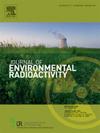Suppression mechanism contributing to the low leaching rate of cesium from incineration bottom ash
IF 1.9
3区 环境科学与生态学
Q3 ENVIRONMENTAL SCIENCES
引用次数: 0
Abstract
After the Fukushima Daiichi nuclear accident, municipal solid waste (MSW) contaminated with radiocesium was generated. In Japan, approximately 80% of MSW by weight has been incinerated. As consequence, radiocesium was retained in incineration residue after the accident. Among the incineration residues, fly ash with high radioactivity was transported to an interim storage facility and special treatment has been carried out. While, bottom ash with radioactivity levels of <8000 Bq kg−1 wet has been directly deposited in conventional MSW landfills. The radiocesium leaching from bottom ash is low, but the reason for this low leaching remains unclear. In this study, leaching tests and microscopic observations of bottom ash containing stable Cs were conducted to investigate the mechanism making Cs leaching low. It is noted that the ash used was simulated ash created from combusting refuse derived fuel (RDF) to which stable Cs was added, not real radioactive ash. Based on pH dependence testing, the Cs leaching increased as the pH decreased. The amount of Cs leached in the neutral range was 2–4% mass of the total content. Electron probe microanalysis, scanning electron microscopy, and energy-dispersive X-ray spectroscopy confirmed that certain particles in bottom ash contain concentrated Cs. These particles were found to comprise aluminum, silicon, potassium, and oxygen at their core, surrounded by concentrated Cs. Raman microscopy suggested that these particles are microcline. Co-heating of microcline with Cs carbonate led to the condensation of Cs in a manner similar to particles observed in bottom ash, and Cs was captured in a glassy substance formed on the microcline surface, which reduced the leaching of Cs.
导致焚烧底灰中铯沥滤率低的抑制机制。
福岛第一核电站事故发生后,产生了受铯污染的城市固体废物(MSW)。在日本,按重量计约有 80% 的城市固体废物被焚化。因此,事故发生后焚烧残留物中保留了铯。在焚烧残渣中,放射性较高的飞灰被运往临时储存设施,并进行了特殊处理。而放射性水平为 -1 湿的底灰,则被直接堆放在传统的都市固体废物填埋场。底灰中的铯沥滤量很低,但沥滤量低的原因仍不清楚。本研究对含有稳定铯的底灰进行了沥滤测试和显微观察,以研究铯沥滤偏低的机理。值得注意的是,所使用的灰烬是燃烧垃圾衍生燃料(RDF)时产生的模拟灰烬,其中添加了稳定铯,而不是真正的放射性灰烬。根据 pH 值相关性测试,随着 pH 值的降低,铯沥滤增加。中性范围内的铯沥滤量为总含量的 2-4%。电子探针显微分析、扫描电子显微镜和能量色散 X 射线光谱分析证实,底灰中的某些颗粒含有高浓度铯。研究发现,这些颗粒的核心由铝、硅、钾和氧组成,周围是高浓度的铯。拉曼显微镜表明这些颗粒是微晶石。微晶石与碳酸铯共同加热导致铯的凝结,凝结方式与底灰中观察到的颗粒相似,铯被捕获在微晶石表面形成的玻璃状物质中,从而减少了铯的沥滤。
本文章由计算机程序翻译,如有差异,请以英文原文为准。
求助全文
约1分钟内获得全文
求助全文
来源期刊

Journal of environmental radioactivity
环境科学-环境科学
CiteScore
4.70
自引率
13.00%
发文量
209
审稿时长
73 days
期刊介绍:
The Journal of Environmental Radioactivity provides a coherent international forum for publication of original research or review papers on any aspect of the occurrence of radioactivity in natural systems.
Relevant subject areas range from applications of environmental radionuclides as mechanistic or timescale tracers of natural processes to assessments of the radioecological or radiological effects of ambient radioactivity. Papers deal with naturally occurring nuclides or with those created and released by man through nuclear weapons manufacture and testing, energy production, fuel-cycle technology, etc. Reports on radioactivity in the oceans, sediments, rivers, lakes, groundwaters, soils, atmosphere and all divisions of the biosphere are welcomed, but these should not simply be of a monitoring nature unless the data are particularly innovative.
 求助内容:
求助内容: 应助结果提醒方式:
应助结果提醒方式:


